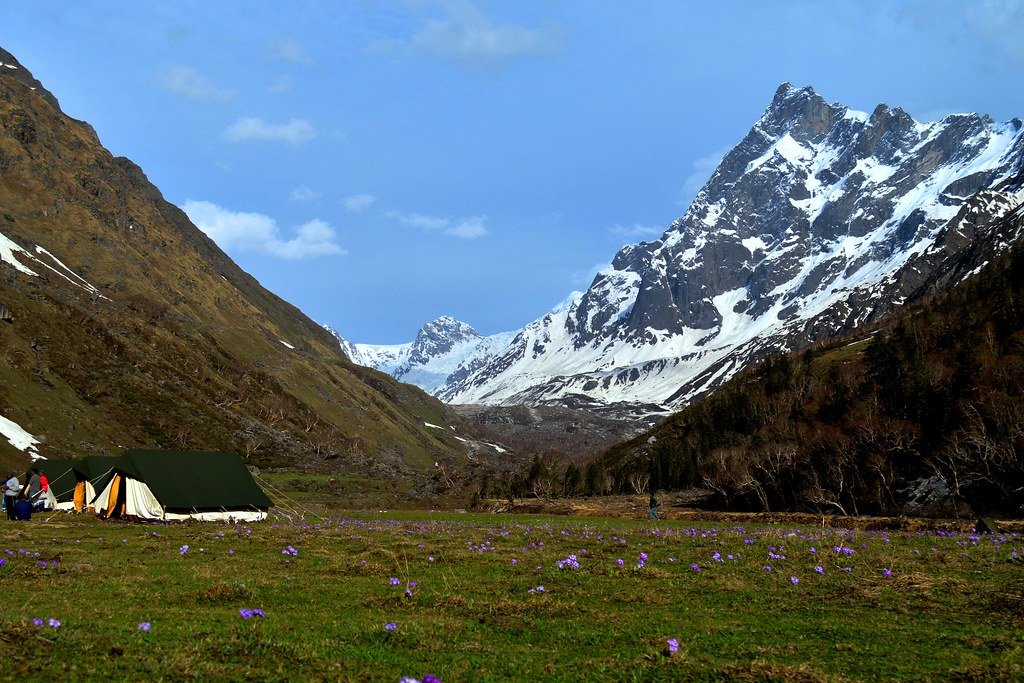Mountains
Beaches
Rainforests
Desserts
National Parks
Har Ki Doon Trek
Har Ki Doon is a valley situated in the Govind Wildlife Sanctuary in the Uttarkashi district of north-west Uttarakhand. It is a cradle-shaped valley that can only be reached by trekking. The distance to the Har Ki Doon valley is 25 km from the road head, making the total trek distance 50 km. It takes 2 to 3 days to reach the valley and another 2 days to return.

Har Ki Doon is a trek that offers a perfect mix of ancient culture and mountain beauty. The valley is surrounded by majestic peaks like Swargarohini, Bandarpunch, and Black Peak. The valley is also rich in flora and fauna, with a variety of flowers, birds, and animals. The valley is home to some of the oldest villages in the region, where the locals still follow their traditional way of life. The temples, deities, and rituals of these villages are from a civilisation we do not know. The trek also takes you through enchanting forests, meadows, and streams, where you can witness the beauty of nature in its purest form.
Here we will guide you through the itinerary, best time, cost, and other details of the Har Ki Doon trek. We will also share some of the best images of the trek that will inspire you to plan your trip.
Itinerary of the Har Ki Doon Trek
The following is the itinerary for the Har Ki Doon trek:
- Day 1: Dehradun to Sankri (220 km drive)
- Day 2: Sankri to Pauni Garaat via Taluka (12 km drive to Taluka, followed by 6 hours walk to Pauni Garaat)
- Day 3: Pauni Garaat to Kalkattiyadhar (8 km walk that takes 6-7 hours)
- Day 4: Kalkattiyadhar to Har Ki Doon & back to Kalkattiyadhar (12 km walk that takes 7-8 hours)
- Day 5: Kalkattiyadhar to Pauni Garaat via Osla (8 km walk that takes 6-7 hours)
- Day 6: Pauni Garaat to Sankri via Taluka (12 km walk that takes 5-6 hours, followed by 12 km drive to Sankri)
- Day 7: Sankri to Dehradun (220 km drive)

Day 1: Dehradun to Sankri
The trek starts from Dehradun, the capital city of Uttarakhand. You can reach Dehradun by train, bus, or flight from Delhi or other major cities. From Dehradun, you will drive to Sankri, the base camp of the trek. The drive is scenic and goes via Mussoorie, Kempty Falls, and Naugaon, where the route to Yamunotri and Sankri diverges. Purola and Mori are two important towns ahead of Naugaon. From Mori, expect little to no network coverage and a bumpy road as we enter Govind Wildlife Sanctuary. The drive takes about 10 hours and covers 220 km. Sankri is a small village that offers a panoramic view of the Himalayan ranges. You can stay at a hotel or guesthouse at Sankri and enjoy the sunset over the mountains.

Day 2: Sankri to Pauni Garaat via Taluka
The second day of the trek starts with a short drive from Sankri to Taluka, the last road ahead. Taluka is a small hamlet that lies on the banks of the Supin river. From Taluka, you will start your walk to Pauni Garaat, a camping site near the river. The trail is mostly level and goes through dense forests of pine, deodar, and walnut. You will also cross some wooden bridges and waterfalls on the way. The walk is easy and takes about 6 hours to cover 12 km. Pauni Garaat is a beautiful spot where you can pitch your tents and relax by the river.

Day 3: Pauni Garaat to Kalkattiyadhar
The third day of the trek is a bit challenging as you will gain some altitude and walk on a steep trail. The trail goes through the forest and offers some glimpses of the snow-clad peaks. You will also pass by some villages like Gangaad and Osla, where you can see the traditional houses and temples of the locals. The trail then ascends to Kalkattiyadhar, a ridge that offers a splendid view of the Har Ki Doon valley. Kalkattiyadhar is a camping site where you can enjoy the sunset and the starry night. The walk takes about 6-7 hours and covers 8 km.

Day 4: Kalkattiyadhar to Har Ki Doon & back to Kalkattiyadhar
The fourth day of the trek is the most rewarding as you will reach the Har Ki Doon valley, the highlight of the trek. The trail descends from Kalkattiyadhar and enters the valley, which is a wide and flat meadow surrounded by mountains. The valley is also known as the Valley of Gods, as it is believed that the Pandavas took this route to ascend to heaven. The valley offers a stunning view of the Swargarohini massif, which is said to be the stairway to heaven. You can also see the Bandarpunch and Black Peak from the valley.

Day 5: Kalkattiyadhar to Pauni Garaat via Osla
The fifth day of the trek is a retracing of the same route that you took on the third day. You will descend from Kalkattiyadhar and pass by Osla, where you can visit the ancient temple of Someshwar, a form of Shiva. You can also interact with the villagers and learn about their culture and lifestyle. You will then continue your walk to Pauni Garaat, where you will camp for the night. The walk takes about 6-7 hours and covers 8 km.

Day 6: Pauni Garaat to Sankri via Taluka
The sixth day of the trek is the last day of walking, as you will return to the road head at Taluka. You will follow the same trail that you took on the second day, through the forest, bridges, and waterfalls. You will reach Taluka in about 5-6 hours, covering 12 km. From Taluka, you will drive back to Sankri, where you can stay at a hotel or guesthouse and celebrate the completion of the trek.
Day 7: Sankri to Dehradun
The seventh day of the trek is the last day of the trip, as you will drive back to Dehradun from Sankri. You will bid farewell to the mountains and the valley and take back some unforgettable memories of the trek. The drive takes about 10 hours and covers 220 km. You can catch your train, bus, or flight from Dehradun to your onward destination.
Best Time to do the Har Ki Doon Trek
The Har Ki Doon trek can be done throughout the year, except for the monsoon season, when the trail becomes slippery and risky due to heavy rains. The best time to do the trek is from April to June and from September to November. These are the seasons when the weather is pleasant and the valley is blooming with flowers. The temperature ranges from 10°C to 25°C during the day and from 0°C to 10°C during the night.
If you are looking for a winter trek, you can also do the Har Ki Doon trek from December to March, when the valley is covered with snow and the views are mesmerizing. The temperature ranges from 0°C to 15°C during the day and from -5°C to 0°C during the night. However, you will need to carry proper winter gear and be prepared for some challenges due to the snow.

Cost of the Har Ki Doon Trek
The cost of the Har Ki Doon trek depends on various factors, such as the duration, the season, the group size, the service provider, and the inclusions and exclusions. Generally, the cost of the trek ranges from Rs. 10,000 to Rs. 15,000 per person, excluding the transportation from Dehradun to Sankri and back. The cost usually includes the following:
- Accommodation in tents and guesthouses
- Meals while on trek and at the base camp
- Trekking permits and fees
- Trekking equipment and gear
- Trek leader and guide
- Support staff and porters
The cost usually excludes the following:
- Transportation from Dehradun to Sankri and back
- Personal expenses and tips
How To Prepare For Har Ki Doon Trek
To prepare for the Har Ki Doon trek, you need to follow some tips and guidelines. Here are some of the things you should do before and during the trek:
- Start training your body for the trek at least a month before. You should do some cardio exercises like running, cycling, or swimming to improve your stamina and endurance. You should also do some strength training to tone your muscles and prevent injuries. You can also practice some yoga or meditation to enhance your breathing and flexibility.
- Keep adequate cash as there is no ATM on the entire trekking route, including the base camp. You should also carry some extra money in case of any emergency or contingency.
- Plan your journey with experienced travel partners and book the trek in advance. You can choose from various trekking companies that offer Har Ki Doon trek packages. These packages include transport, accommodation, meals, and a guide. It is advisable to book your tour in advance to avoid any last-minute hassle. You can also compare the prices and reviews of different companies online and choose the best one for you.
- Avoid planning the Har Ki Doon trek during the monsoon as the route tends to be slippery and risky due to heavy rains.

- You should pack light and avoid carrying any unnecessary weight. You should carry a good quality backpack, a sleeping bag, a trekking pole, a water bottle, a torch, a first aid kit, a sunscreen, a hat, a pair of sunglasses, a raincoat, a jacket, a sweater, a pair of gloves, a pair of socks, a pair of trekking shoes, a pair of sandals, a towel, a toiletry kit, and some personal medication. You should also carry some dry fruits, chocolates, energy bars, and glucose for instant energy.
- Follow the instructions and advice of your guide and respect the local culture and environment.
Difficulty level of Har Ki Doon Trek
The Har Ki Doon trek is classified as easy to moderate in difficulty level1. The terrain is quite smooth and easy to trek, but the long distances of 10 km to be hiked every day make the trek slightly more challenging than the ones suited for beginners. The trek involves a variety of terrains, including steep ascents and descents, rocky paths, meadows, and forest trails2. Trekkers should be prepared to navigate these terrains with proper trekking gear2. The trek also requires a good level of stamina and endurance, as the trekking duration is 6 nights/7 days and the highest altitude is 11,675 ft. at Har Ki Doon2. Trekkers should start training their body for the trek at least a month before

Is there any age limit for the Har Ki Doon Trek?
There is an age limit for the Har Ki Doon trek. The minimum age limit for a child who wants to do this trek is 9 to 10 years. The maximum age limit for an adult who wants to join the trek is 60 years. These age limits are set by the trekking companies and organizations that offer Har Ki Doon trek packages, as the trek involves some physical challenges and high altitude. Therefore, if you want to do the Har Ki Doon trek, you should check your eligibility and fitness level before booking the trek.
How To Get Paas For Har Ki Doon Trek?
To get a pass for the Har Ki Doon trek, you need to obtain a local forest permit from the Govind Wildlife Sanctuary. Travel companies shows it mandatory but You can purchase the tickets at the entrance of the sanctuary and there is no paper work involved. However, you also need to carry your identification cards such as driving license or voter ID along with a passport size photo, a medical certificate ensuring your fitness for the trek and a disclaimer certificate ensuring your submission to voluntarily participate in this trek. The cost of the permit may vary depending on the season and the duration of the trek. If you want the exact amount for the ticket, you can call the forest department’s Govind Pashu office at 01373223433 or on their [official website].

However, be prepared to deal with some rude staff who may not be very helpful. Alternatively, you can book the trek with a reputed trekking company or organization that will take care of the permits and other arrangements for you. You can choose from various trekking packages that include transport, accommodation, meals, and a guide. You can compare the prices and reviews of different companies online and choose the best one for you.
Is Har Ki Doon Trek Possible Without Guide ?
The Har Ki Doon trek is a beautiful and scenic trek in the Uttarakhand region of India.
- However, it is not recommended to do it without a guide, especially if you are a beginner or unfamiliar with the terrain. But hiring a guide is not mandatory if you are well known person you can do it on his own.
The reasons for hiring a guide are:
- The trek is not well-marked and there are chances of getting lost or taking a wrong turn. A guide can help you navigate the trail and avoid any mishaps.
- The trek involves crossing rivers, bridges, and steep slopes, which can be challenging and risky. A guide can assist you with the crossings and ensure your safety.
- The trek passes through remote villages and forests, where you may encounter wildlife or locals. A guide can help you interact with them and respect their culture and customs.
- The trek requires proper planning and preparation, such as arranging permits, transportation, accommodation, food, and equipment. A guide can take care of these aspects and make your trek hassle-free and enjoyable.
- I suggest you hire a guide from a reputed trekking company or agency, who can provide you with all the necessary services and support.
You can find some options and details on the websites I have searched for you.
Book Your Trip With:-
I can suggest some websites and travel companies who offer trekking packages for Har Ki Doon. Here are some of the options you can consider:
- Har Ki Dun Trek: A Complete Review of the Top 10 Packages and Services in 2023



